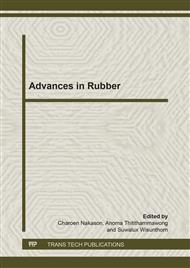p.391
p.395
p.399
p.406
p.410
p.417
p.421
p.425
p.429
A Rapid Quantitative Analysis of Native Antioxidants in Natural Rubber (Hevea brasiliensis) During Maturation
Abstract:
Natural rubber (NR) obtained from H. brasiliensis is known to be susceptible to oxidative degradation according to the amount of double bonds in the structure of the polymer, i.e. poly (cis-1,4-isoprene) [1]. However NR has been reported to contain native antioxidants such as phytosterols, phospholipids and tocotrienols [2]. Among those, γ-tocotrienol, present in hevea latex was reported to exhibit “in-vitro” antioxidant activity [3]. However the direct involvement of γ-tocotrienol or other antioxidants naturally present in NR in the protection of NR against oxidation is difficult to assess as the works were carried out with different of rubber types and in different conditions [4,5]. In the framework of a work on the dynamics of γ-tocotrienols in NR samples obtained from coagula maturated during several durations (0 to 15 days) in parallel with measurement of standard properties such as P0 and PRI, methodological development of the analysis of tocotrienols and derivatives is presented in this study.HPLC-MS has been shown to be an accurate technique for lipid analysis in NR [6]. However, this is a time-consuming technique especially with large number of samples due to a necessary step of saponification. Moreover, the structures of γ-tocotrienol and its dimers were found to be affected by the strong alkali condition of saponification (data not shown). Therefore a rapid quantitative method for γ-tocotrienol from NR using high performance thin layer chromatography (HP-TLC) has been developed. Lipid extracts from NR samples could be simply analyzed by HP-TLC without any derivatization and the detectable quantity could be in nanogram range. Statistical analysis of the data showed that the method is precise, accurate, reproducible and sensitive. Thus the proposed HP-TLC method can be successfully used for the quantification of γ-tocotrienol from NR samples. This technique will be useful to conduct further experiments on antioxidant activity of NR lipids and to relate the results with physical properties of NR, especially those linked to resistance to oxidation.
Info:
Periodical:
Pages:
410-414
Citation:
Online since:
November 2013
Price:
Сopyright:
© 2014 Trans Tech Publications Ltd. All Rights Reserved
Share:
Citation:


